KitchenAid KBRC36FMS, KBLC36FMS, KBRS36FMB, KBRS36FMX, KBLS36FMB Installation Instructions
...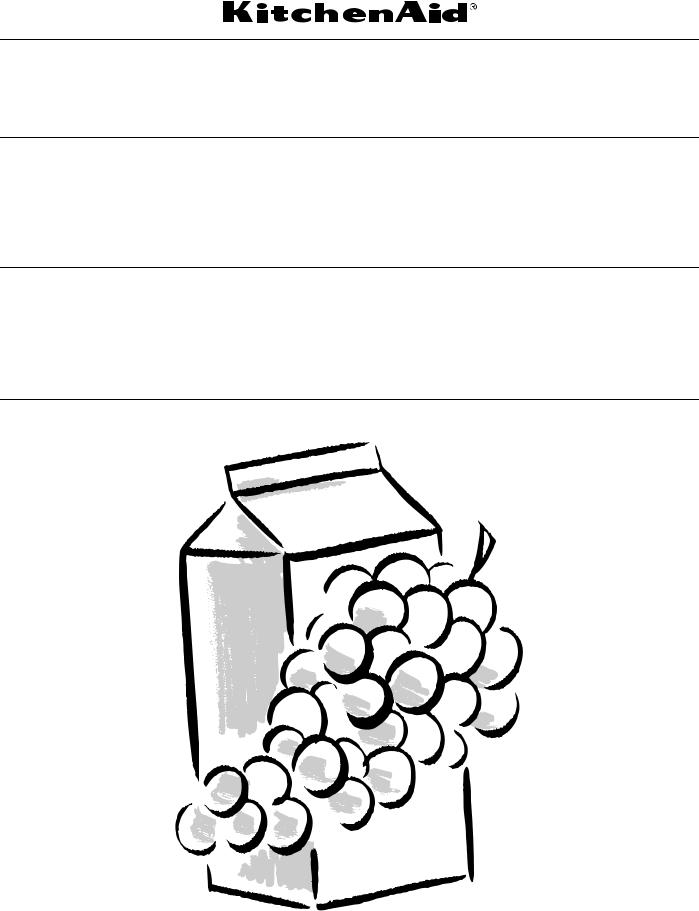
BOTTOM-MOUNT BUILT-IN REFRIGERATOR
InstallationGuide
IMPORTANT: READ AND SAVE THESE INSTRUCTIONS. INSTALLATION REQUIRES 2 OR MORE PEOPLE.
REFRIGERADOR EMPOTRADOS
CON MONTAJE INFERIOR
Manualdeinstalación
IMPORTANTE: LEA Y GUARDE ESTAS INSTRUCCIONES. LA INSTALACIÓN REQUIERE DE 2 O MÁS PERSONAS.
RÉFRIGÉRATEUR ENCASTRÉ AVEC CONGÉLATEUR EN DESSOUS
Guided’Installation
IMPORTANT : LIRE ET CONSERVER CES INSTRUCTIONS. L’INSTALLATION NÉCESSITE L’INTERVENTION DE 2 PERSONNES OU PLUS.
Table of Contents/Índice/Table des matières.................................................................. |
2 |
2307890A

TABLE OF CONTENTS
REFRIGERATOR SAFETY ............................................................. |
3 |
DESIGN SPECIFICATIONS............................................................ |
4 |
Product Dimensions..................................................................... |
5 |
Tipping Radius ............................................................................. |
6 |
Door Swing Dimensions............................................................... |
6 |
Handle and Door Clearances....................................................... |
7 |
Classic, Architect®, and Overlay Series |
|
Factory Panels and Kits ............................................................. |
10 |
Classic Series Custom Panels................................................... |
10 |
Overlay Series Custom Panels .................................................. |
11 |
Architect® Series Custom Side Panels....................................... |
12 |
Classic and Overlay Series Custom Side Panels ...................... |
13 |
INSTALLATION REQUIREMENTS .............................................. |
14 |
Tools and Parts .......................................................................... |
14 |
Location Requirements.............................................................. |
14 |
Electrical Requirements ............................................................. |
15 |
Water Supply Requirements...................................................... |
15 |
INSTALLATION INSTRUCTIONS ................................................ |
16 |
Unpack the Refrigerator............................................................. |
16 |
Reduce Tipping Radius.............................................................. |
16 |
Move the Refrigerator into House.............................................. |
17 |
Install Anti-Tip Boards................................................................ |
17 |
Connect the Water Supply......................................................... |
18 |
Plug in Refrigerator..................................................................... |
19 |
Move Refrigerator to Final Location........................................... |
19 |
Lower Leveling Legs .................................................................. |
19 |
Install Classic Series Custom Panels......................................... |
19 |
Install Overlay Series Custom Panels ........................................ |
20 |
Level Refrigerator ....................................................................... |
21 |
Adjust and Remove Door........................................................... |
22 |
Install Side Panel ........................................................................ |
22 |
Install Base Grille........................................................................ |
23 |
Water System Preparation ......................................................... |
23 |
Complete Installation.................................................................. |
23 |
ÍNDICE
SEGURIDAD DEL REFRIGERADOR........................................... |
24 |
ESPECIFICACIONES DE DISEÑO .............................................. |
25 |
Medidas del producto................................................................ |
26 |
Arco de vuelco ........................................................................... |
27 |
Medidas de oscilación de la puerta........................................... |
27 |
Espacios para la agarradera y la puerta .................................... |
28 |
Paneles y juegos de fábrica de la |
|
Serie Classic, Architect® y Overlay............................................. |
31 |
Paneles de la puerta a la medida para la Serie Classic ............ |
31 |
Paneles a la medida de la Serie Overlay ................................... |
32 |
Paneles laterales a la medida para la Serie Architect®............. |
33 |
Paneles laterales a la medida para |
|
las Serie Classic y Overlay......................................................... |
34 |
REQUISITOS DE INSTALACIÓN................................................. |
35 |
Piezas y Herramientas ............................................................... |
35 |
Requisitos de ubicación............................................................. |
35 |
Requisitos eléctricos.................................................................. |
36 |
Requisitos del suministro de agua............................................. |
37 |
INSTRUCCIONES DE INSTALACIÓN......................................... |
37 |
Cómo desempacar su refrigerador............................................ |
37 |
Cómo reducir el arco de vuelco................................................. |
38 |
Cómo hacer entrar el refrigerador en la casa ............................ |
38 |
Cómo instalar los tableros antivuelco........................................ |
39 |
Conexión del suministro de agua .............................................. |
39 |
Cómo enchufar el refrigerador................................................... |
40 |
Ubicación final del refrigerador .................................................. |
41 |
Baje las patas niveladoras ......................................................... |
41 |
Cómo instalar los paneles a la medida para la Serie Classic.... |
41 |
Cómo instalar los paneles a la medida para la Serie Overlay ... |
42 |
Cómo nivelar el refrigerador....................................................... |
43 |
Cómo ajustar y quitar las puertas .............................................. |
44 |
Cómo instalar el panel lateral..................................................... |
45 |
Cómo instalar la rejilla de la base .............................................. |
45 |
Preparación del sistema de agua .............................................. |
46 |
Cómo terminar la instalación ..................................................... |
46 |
TABLE DES MATIÈRES
SÉCURITÉ DU RÉFRIGÉRATEUR .............................................. |
47 |
SPÉCIFICATIONS DE DESIGN.................................................... |
48 |
Dimensions du produit............................................................... |
49 |
Rayon de basculement .............................................................. |
50 |
Dimensions pour le pivotement des portes............................... |
50 |
Dégagements pour les poignées et portes ............................... |
51 |
Ensembles de panneaux d'origine de la |
|
Série Classic, Architect® et Overlay............................................ |
54 |
Panneaux personnalisés de la Série Classic............................. |
54 |
Panneaux personnalisés de la série Overlay............................. |
55 |
Panneaux latéraux personnalisés de la Série Architect®.......... |
56 |
Panneaux latéraux personnalisés |
|
des Séries Classic et Overlay .................................................... |
57 |
EXIGENCES D’INSTALLATION................................................... |
58 |
Outillage et pièces nécessaires ................................................. |
58 |
Exigences d’emplacement......................................................... |
58 |
Spécifications électriques ......................................................... |
59 |
Spécifications de l’alimentation en eau ..................................... |
60 |
INSTRUCTIONS D’INSTALLATION............................................. |
60 |
Déballage du réfrigérateur.......................................................... |
60 |
Réduction du rayon de basculement......................................... |
61 |
Faire entrer le réfrigérateur dans le domicile ............................. |
61 |
Installation de planches antibasculement.................................. |
62 |
Raccordement de la canalisation d'eau .................................... |
62 |
Brancher le réfrigérateur............................................................. |
63 |
Déplacement du réfrigérateur à l'emplacement final................. |
63 |
Déploiement des pieds de nivellement...................................... |
63 |
Installation des panneaux personnalisés de la Série Classic.... |
64 |
Installation des panneaux personnalisés de la Série Overlay ... |
65 |
Nivellement du réfrigérateur....................................................... |
66 |
Ajustement et enlèvement des portes ....................................... |
66 |
Installation du panneau latéral ................................................... |
67 |
Installation de la grille de la base ............................................... |
68 |
Préparation du système d’eau ................................................... |
68 |
Achever l’installation .................................................................. |
68 |
2
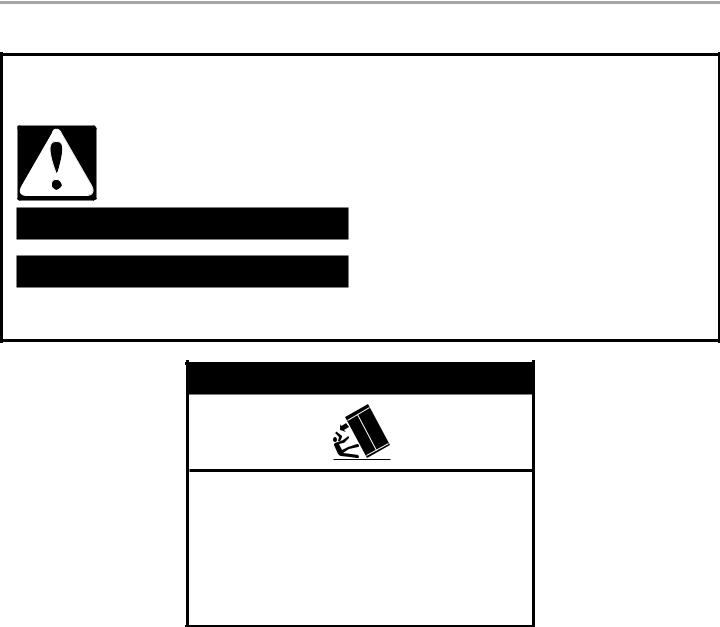
REFRIGERATOR SAFETY
Your safety and the safety of others are very important.
We have provided many important safety messages in this manual and on your appliance. Always read and obey all safety messages.
This is the safety alert symbol.
This symbol alerts you to potential hazards that can kill or hurt you and others.
All safety messages will follow the safety alert symbol and either the word “DANGER” or “WARNING.” These words mean:
 DANGER
DANGER
 WARNING
WARNING
You can be killed or seriously injured if you don't immediately follow instructions.
You can be killed or seriously injured if you don't follow instructions.
All safety messages will tell you what the potential hazard is, tell you how to reduce the chance of injury, and tell you what can happen if the instructions are not followed.
 WARNING
WARNING
Tip Over Hazard
Refrigerator is top heavy and tips easily when not completely installed.
Keep doors taped closed until refrigerator is completely installed.
Use two or more people to move and install refrigerator.
Failure do so can result in death or serious injury.
3
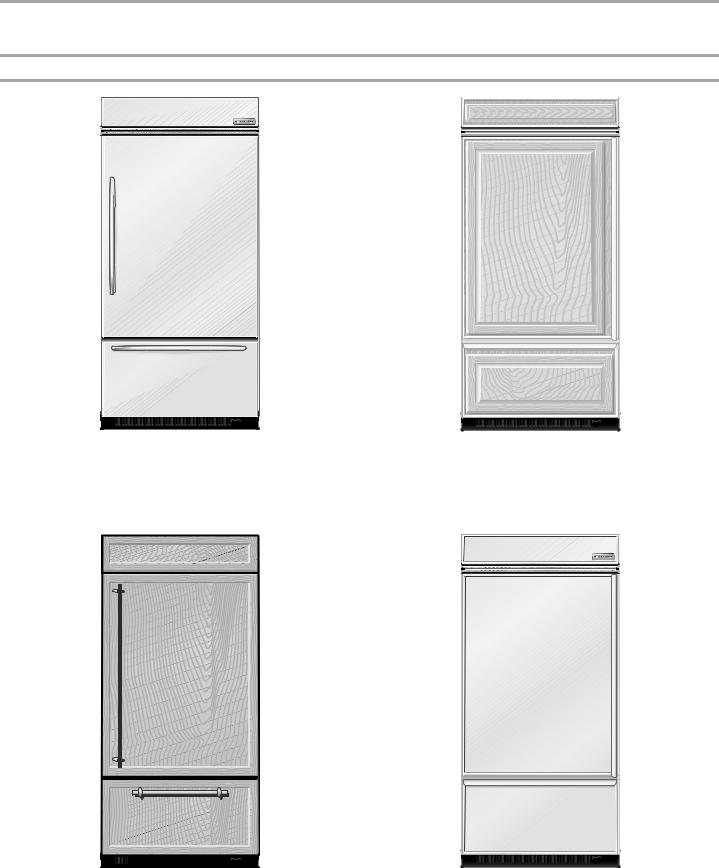
DESIGN SPECIFICATIONS
Models
Architect® Series
Features wraparound styling that complements the contoured door handles. This series provides a warm commercial-looking built-in refrigerator.
KBRC36FMS KBLC36FMS
Overlay Series
Features factory-installed, overlay style trim, to provide a “frameless” look. This series requires the installation of custom panels, handles, and standoffs.
KBRO36FMX KBLO36FMX
Classic Series
Features traditional style trim, factory-installed, to provide a “framed” look. This series requires the installation of custom panels that are not included.
KBRS36FMB KBRS36FMX KBLS36FMB
KBLS36FMX
Complete Series
Features factory-installed stainless steel trim and panels to create a sleek, contemporary look.
KBRP36FMS KBLP36FMS
4
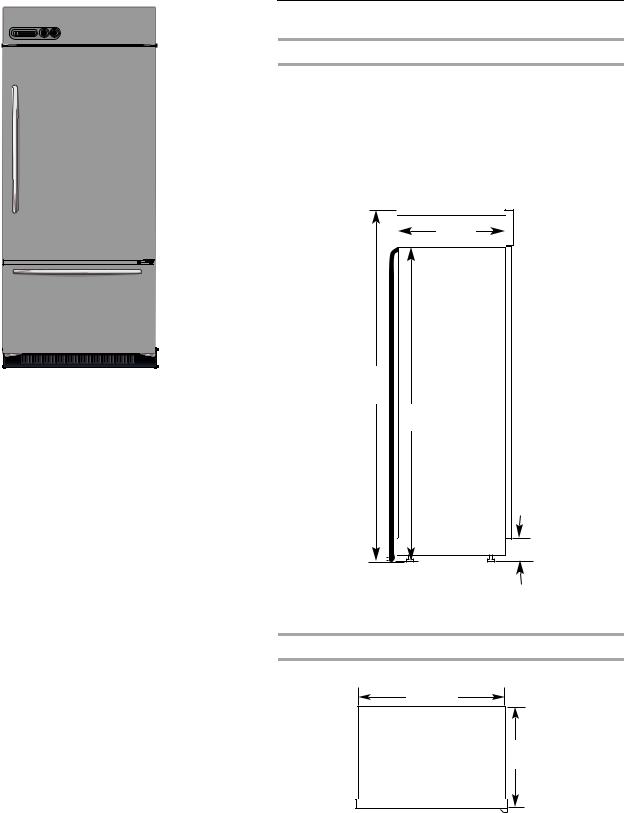
Pro LineTM Series
Features extraordinary design and exceptional levels of performance. This series is a perfect blend of form and function delivering professional quality, durability and simplicity.
KBRV36FPM KBRV36FPS KBLV36FPM
KBLV36FPS
ProductDimensions
Side View
■The depth from the front of the top grille to the back of the refrigerator cabinet is 25¹⁄ " (64 cm).
■The power cord is 84" (213 cm) long.
■The water line attached to the back of the refrigerator is 5 ft. (1.5 m) long. Height dimensions are shown with leveling legs extended ¹⁄ " (3 mm) below the rollers.
25¹⁄ "
 (64 cm)
(64 cm) 

23¹⁄ "
(60 cm)
*83¹⁄ "
(211 cm)
84" (213 cm) Power Cord
*3¹⁄ " (9 cm)
*When leveling legs are fully extended to 1¹⁄ " (32 mm) below rollers, add 1¹⁄ " (29 mm) to the height dimensions.
Top View
35 ⁄ "
(90 cm)
25¹⁄ "
(64 cm)
5
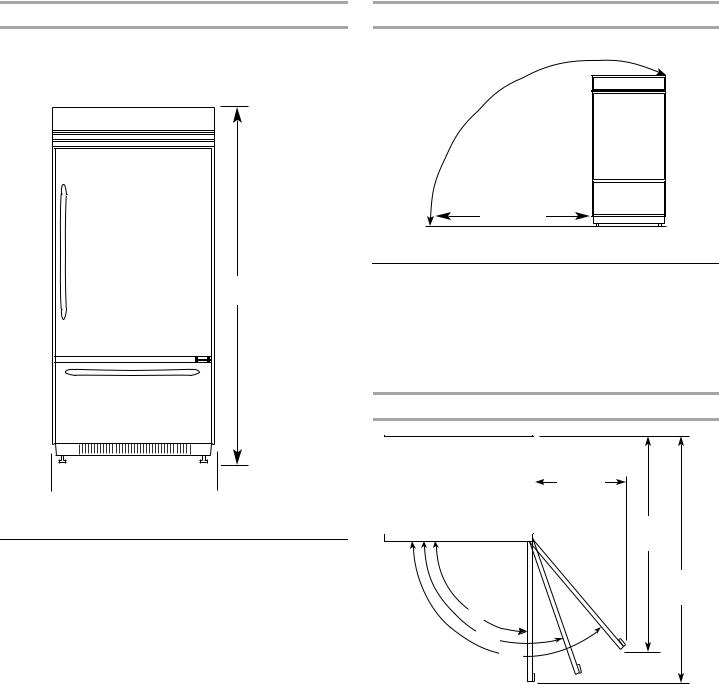
Front View
■Width dimensions were measured from trim edge to trim edge.
■Height dimensions are shown with leveling legs extended ¹⁄ " (3 mm) below the rollers.
*83¹⁄ "
(211 cm)
 36¹⁄ " (92 cm)
36¹⁄ " (92 cm) 
*When leveling legs are fully extended to 1¹⁄ " (32 mm) below rollers, add 1¹⁄ " (29 mm) to the height dimensions.
TippingRadius
Be sure there is adequate ceiling height to stand the refrigerator upright when it is moved into place.
■The dolly wheel height must be added to the tipping radius when a dolly is used.
■If needed, the tipping radius can be reduced. See “Reduce Tipping Radius.”
Side Tipping Radius
NOTE: Tip on side only.
A 
90¹⁄ "
(229.9 cm)
A. Tip this side only
DoorSwingDimensions
The location must permit the door to open to a minimum of 90°. Allow 4¹⁄ " (11.4 cm) minimum space between the side of the refrigerator and a corner wall.
NOTE: More clearance may be required if you are using overlay panels or custom handles.
To adjust the door swing, see “Adjust and Remove Door.”
36" (91 cm) Models
23" (58 cm)
51" (130 cm)
59" (150 cm)
90˚
110˚
130˚
6
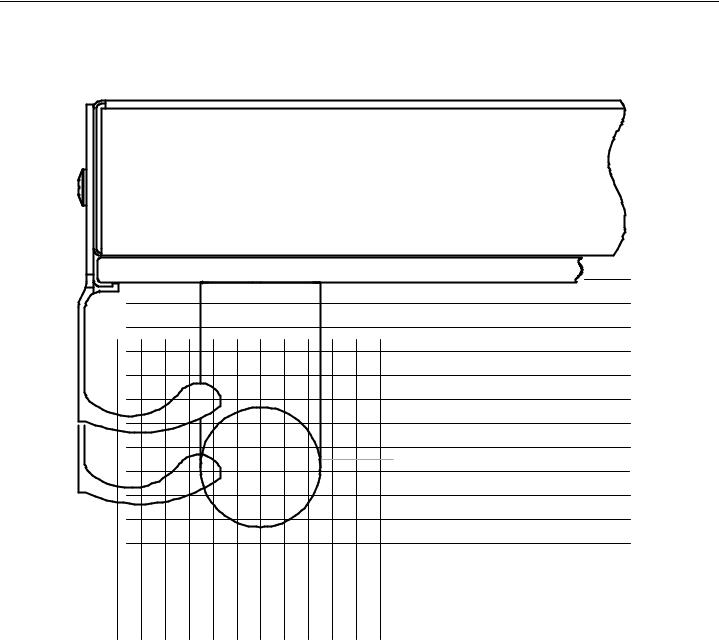
HandleandDoorClearances
If you are installing custom panels, the panels must allow certain clearances for the handles and for the door to swing open. First, determine the types of handles you will be using and the door stop setting. Then, choose the appropriate scale drawing to use as a template for creating the panels.
Door
Custom Panel
|
1/4" (6.35 mm) |
|
|
1/2" (1.3 cm) |
|
Classic |
3/4" (1.9 cm) |
|
1" (2.5 cm) |
||
Handle |
||
11/4" (3.2 cm) |
||
|
||
|
11/2" (3.8 cm) |
|
|
13/4" (4.4 cm) |
|
Optional |
2" (5.1 cm) |
|
Extended |
Architect® Handle |
|
21/4" (5.7 cm) |
||
Handle |
21/2" (6.4 cm) |
|
|
23/4" (7 cm) |
|
|
3" (7.6 cm) |
|
|
Handle Dimensions |
|
|
Actual Size |
1" |
2" |
3" |
(2.5 cm) |
(5.1 cm) |
(7.6 cm) |
7
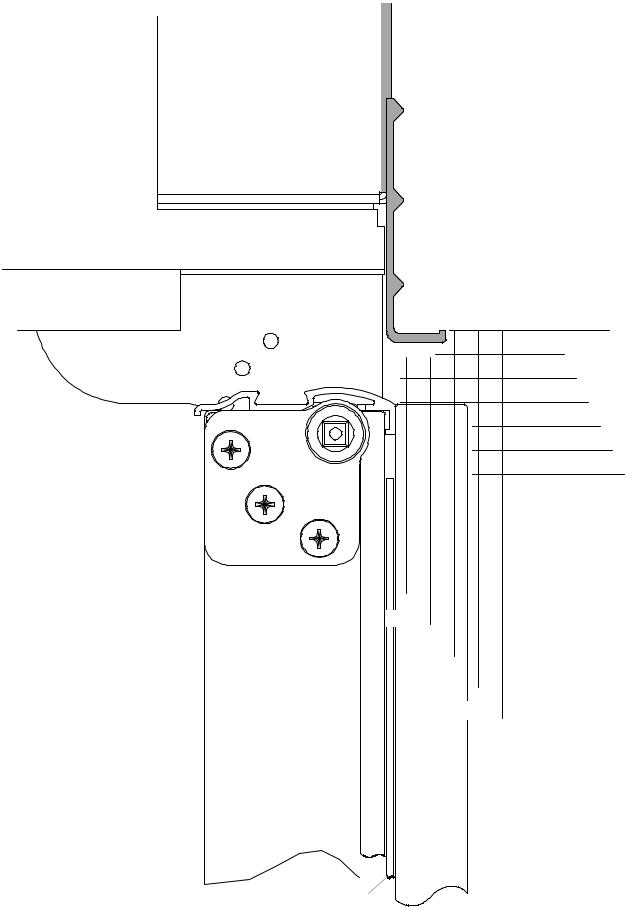
Overlay Series
Door Swing 90˚
Actual Size
Refrigerator to
Cabinetry Clearance
Refrigerator
Side Trim
Hinge
| <![if ! IE]> <![endif]>Door |
<![if ! IE]> <![endif]>Backer |
|
<![if ! IE]> <![endif]>Panel |
|
|
1/4" (6.35 mm)
1/2" (1.3 cm)
3/4" (1.9 cm)
1" (2.5 cm)
11/4" (3.2 cm)
11/2" (3.8 cm)
1/2"
(1.3 cm)
3/4"
(1.9 cm)
1" (2.5 cm)
|
11/4" |
||
| <![if ! IE]> <![endif]>PanelOverlay |
(3.2 |
cm) |
|
11/2" |
|||
|
|||
(3.8 cm)
Spacer Panel
8
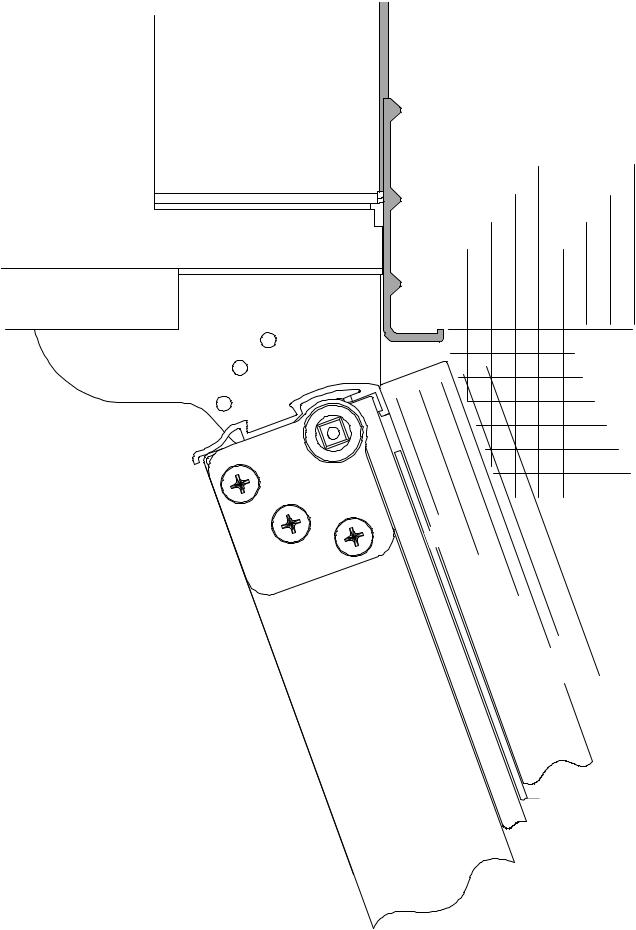
NOTE: Do not place the door stop screw in the 130˚ position on Overlay Series models. See “Adjust and Remove Door.”
Overlay Series
Door Swing 110˚
Actual Size
Refrigerator to
Cabinetry Clearance
Refrigerator |
1" |
|
2" |
Side Trim |
(2.5 cm) |
(5.1 cm) |
|
|
3/4" |
|
13/4" |
(1.9 cm) |
|
(4.4 cm) |
|
1/2" |
|
|
11/2" |
(1.3 cm) |
|
(3.8 cm) |
|
1/4" |
|
11/4" |
|
(6.35 mm) |
(3.2 cm) |
||
Hinge |
|
|
|
|
1/4" (6.35 mm) |
|
|
|
|
1/2" (1.3 cm) |
|
|
|
|
|
|
3/4" (1.9 cm) |
|
|
|
|
|
1" (2.5 cm) |
|
|
|
|
|
11/4" (3.2 cm) |
|
|
|
|
|
11/2" (3.8 cm) |
|
|
1/2" |
|
|
|
|
|
(1.3 cm) |
|
|
|
|
|
3/4" |
|
|
|
|
|
(1.9 cm) |
|
|
|
|
|
|
|
1" |
|
|
|
(2.5 cm) |
|
||
|
|
|
Overlay |
11/4" |
|
|
|
|
|
|
|
|
|
Backer |
|
|
(3.2 cm) |
|
Door |
|
|
11/2" |
|
|
|
|
|
||
|
|
|
|
(3.8 cm) |
|
|
Panel |
Panel |
|||
|
|
||||
|
|
|
|
||
|
|
|
|
|
Spacer Panel |
9
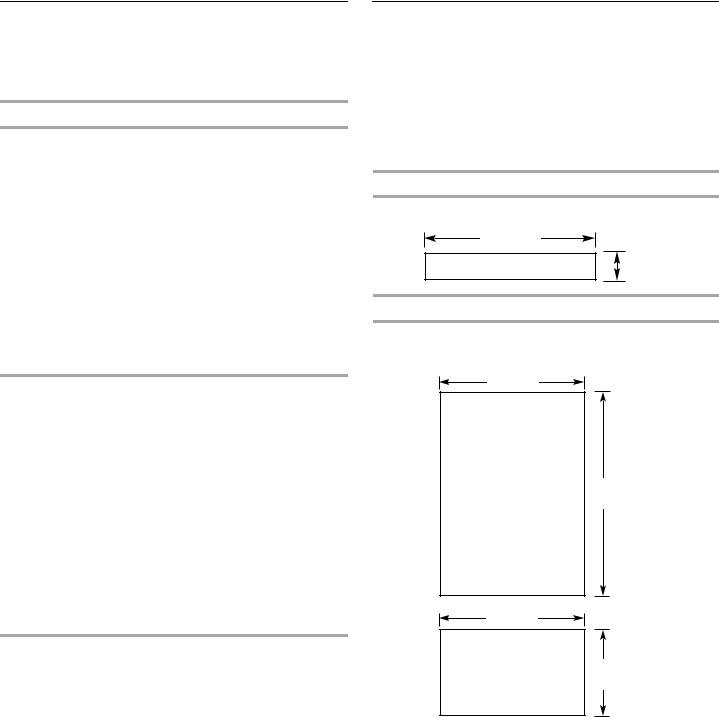
Classic,Architect®,andOverlaySeries
Factory Panels and Kits
All factory parts are available through your KitchenAid dealer or by calling KitchenAid Parts and Accessories at 1-800-442-9991. In Canada, call 1-800-807-6777.
Factory Door Panel Kits
Four kits containing colored acrylic or stainless steel door and top grille panels are available. Follow the kit instructions for installing the panels.
NOTE: Panel kits are not required for factory-installed stainless steel panel models.
Color |
36" (91 cm) |
|
|
White |
#2300072 |
|
|
Black |
#2300073 |
|
|
Stainless Steel |
#2300074 |
|
|
|
|
Classic and Architect® Series 72" (183 cm) Top Grille Panel Kit
72" (183 cm) wide Top Grille Panel Kits are available. These kits allow 2 units (one left-hand swing and one right-hand) to be installed side by side with a single grille.
Color |
72" (183 cm) |
|
|
White |
#2300075 |
|
|
Black |
#2300076 |
|
|
Stainless Steel (Classic Series) |
#2300077 |
|
|
Stainless Steel (Architect® Series) |
#2302797 |
|
|
Overlay |
#2300078 |
|
|
|
|
Extended Door Handle Kits
Use extended door handles when additional finger clearance is needed between the door handles and custom panel. Follow the kit instructions for installing the door handles.
Color |
Left-Hand |
Right-Hand |
|
Swing |
Swing |
|
|
|
White (Classic |
#4396119 |
#8171424 |
Series) |
|
|
|
|
|
Black (Classic |
#4396116 |
#8171427 |
Series) |
|
|
|
|
|
Stainless Steel |
#4396118 |
#8171425 |
(Classic Series) |
|
|
|
|
|
Matte Aluminum |
#4396120 |
#8171423 |
Etched (Classic |
|
|
Series) |
|
|
|
|
|
Matte Aluminum |
#4396718 |
|
(Overlay Series) |
|
|
|
|
|
ClassicSeriesCustomPanels
If you plan to install custom wood panels, you will need to create the panels yourself or consult a qualified cabinetmaker or carpenter. See dimension drawings for panel specifications.
IMPORTANT: Panels weighing more than recommended may cause damage to your refrigerator.
NOTE: Dimensions shown have a (±)¹⁄ " (1.5 mm) tolerance. Panels that are more than ¹⁄ " (6.35 mm) thick must be routed. If panels are less than ¹⁄ " (6.35 mm) thick, install a filler panel between the door and the decorative panel.
Top Grille Panel
The top panel should not weigh more than 10 lbs (4.5 kg).
34¹⁄ "
(87.63 cm)
7¹⁄ "
(18.4 cm)
Refrigerator and Freezer Panels
The freezer panel should not weigh more than 30 lbs (13 kg). The refrigerator panel should not weigh more than 50 lbs (22 kg).
34¹⁄ "
(87 cm)
49"
(124.5 cm)
34¹⁄ "
(87 cm)
20¹⁄ "
(51.1 cm)
10

Top Grille Panel – Routing Requirements
Top and bottom edges of the top panel should be edge routed ¹⁄ " (1.3 cm) and ³⁄ " (9.5 mm), respectively. Both ends should be edge-routed ⁄ " (2.2 cm) as shown.
¹⁄ " |
|
|
|
|
|
|
|
|
|
|
|
|
(6.35 mm) |
|
|
|
|
|
|
|
|
|
|
|
|
|
|
|
|
|
|
|
|
|
|
|
||
max. |
|
|
|
|
Top |
Top |
||||||
|
|
|
|
|
|
|
|
|||||
|
|
|
|
|
|
|
|
Grille |
Grille |
|||
|
|
|
|
|
|
|
|
|
|
|
||
|
|
|
|
|
|
|
|
|
|
|
|
|
|
|
|
|
|
⁄ " |
|
|
|
|
|
⁄ " |
|
|
|
|
|
|
|
|||||||
|
|
|
|
|
(2.2 cm) |
|
|
(2.2 cm) |
||||
¹⁄ "
(6.35 mm) max.
NOTE: When creating a panel with face detail, the offsets will be hidden and must be accounted for in order to center the detail in the top grille.
¹⁄ " (1.3 cm) min.
Center face detail between offsets
³⁄ " (9.5 mm)
min.
¹⁄ "
(6.35 mm) max.
Top
Bottom
¹⁄ "
(6.35 mm) max.
Door Panel – Routing Requirements
If an extended handle kit is used, then routing the handle side of the door and drawer panels is not required. See “Classic, Architect®, and Overlay Series Factory Panels and Kits” for more information on ordering extended handles.
If the standard handle is used, rout the entire handle side 3¹⁄ " (8.25 cm) to allow for finger clearance. Then rout the other side 1" (2.54 cm).
Standard Handle – Top View
3¹⁄ "
(8.25 cm)
|
min. |
|
Hinge Side |
| <![if ! IE]> <![endif]>Handle |
¹⁄ " (6.35 mm) max. |
Door |
Door |
|
|||
|
Panel |
Panel |
|
|
2" (5 cm) |
|
1" |
|
min. |
|
(2.54 cm) |
Door Panel - Side View
¹⁄ "
(6.35 mm) max.
¹⁄ " (1.
<![if ! IE]><![endif]>Panel
OverlaySeriesCustomPanels
Custom overlay panels allow you to blend the exterior of your refrigerator into the overall kitchen décor and to use custom handles for additional design flexibility.
The custom panels must have backer panels attached in order to mount them to the refrigerator. It is most common to work with three panels, as shown in the following graphic: a decorative overlay panel, a ¹/ " (3.18 mm) spacer panel or spacer strips and a ¹/ " (6.35 mm) backer panel.
Overlay Panel |
Spacer Panel |
||
|
|
||
|
|
Backer Panel |
|
5/8" to 3/4" |
|
1/4" |
|
(15.88 to |
|
||
1/8" |
(6.35 mm) |
||
19.05 mm) |
|||
(3.18 mm) |
|
||
|
|
||
Spacer Panel |
1/8" |
(3.18mm) |
1" minimum |
(2.54 mm) |
Door/Grille Trim |
Offset Dimension |
In some cases, your cabinet manufacturer may choose to work with one panel routed for the different dimensions. Follow these panel dimension and placement instructions to be sure that the custom overlay panels will fit properly.
IMPORTANT:
■The weight of the refrigerator door overlay panel cannot exceed 50 lbs (23 kg).
■The weight of the freezer drawer overlay panel cannot exceed 30 lbs (13.5 kg).
■The weight of the top grille overlay panel cannot exceed 10 lbs (4.5 kg).
To minimize panel weight, you may use 2" (5.08 cm) spacer strips around the perimeter in place of full-sheet solid spacer panels. The spacer strips must be set in at least 1" (2.54 cm) from the top, bottom and side edges of the backer panel. If you use spacer strips, it is also recommended that you use two 2"
(5.08 cm) strips horizontally centered for added support.
11

NOTE: For the grille and the door panels to be flush, the overlay door panel should be ¹⁄" (6.35 mm) thicker than the overlay grille panel.
■The side panel should be a minimum of ¹⁄" (12 mm) thick to prevent warping.
■If the opening depth is 25" (63.5 cm) or more, you may want to install a support board on the rear wall.
|
|
|
|
|
|
|
|
|
|
|
|
341/2" |
|
|
|
|
|
|
|
|
Refrigerator |
|||||||||||
|
|
|
|
|
|
73/8" |
(87.63 cm) |
|
|
|
|
|
|
|
|
|||||||||||||||||
|
|
|
|
|
|
|
|
|
|
|
|
|
|
|
|
|
|
|
|
|
|
|
|
|
|
|
||||||
|
|
|
|
|
|
|
|
|
|
|
|
|
|
|
|
|
|
|
|
|
|
|
|
|
|
|
||||||
|
|
|
|
|
|
|
|
|
|
(18.73 cm) |
|
|
|
|
|
|
|
|
|
|
|
|
||||||||||
|
|
|
|
|
|
|
|
|
|
|
|
24¹⁄ |
" |
|
|
|
|
|
||||||||||||||
|
|
|
|
|
|
|
|
|
|
|
|
|
|
|
|
|
|
|
|
|
|
|
|
|
|
|||||||
81/2" |
|
|
|
|
|
|
|
|
|
|
|
|
|
|
|
|
|
(61.3 |
cm) |
|
|
|
||||||||||
|
|
|
|
|
|
|
|
|
341/2" (87.63 cm) |
|
|
|
|
|
||||||||||||||||||
(21.59 cm) |
|
|
|
|
|
|
|
|
|
|
|
|
|
|
|
|
|
|
|
|
|
23 |
¹¹⁄ " |
|
||||||||
|
|
|
|
|
|
|
|
|
|
|
|
|
|
|
|
|
||||||||||||||||
|
|
|
|
|
|
|
|
|
|
|
|
|
|
|
|
|
|
|
|
|
|
|
|
|
(60.3 cm) |
|
||||||
|
|
|
|
|
|
|
|
|
|
|
|
|
|
|
|
Bottom Offset |
||||||||||||||||
|
|
|
|
|
|
|
|
|
|
|
|
|
|
|
|
|
|
|
|
|
|
|
23¹⁄ " |
|||||||||
|
|
|
|
|
|
|
|
|
|
|
|
|
|
|
|
|
|
|
|
|
|
|
||||||||||
|
|
|
|
|
|
|
|
|
|
|
|
|
|
|
|
1" (2.54 cm) |
|
|
|
|
|
|
|
(59.7 cm) |
||||||||
|
|
|
|
|
|
|
|
341/2" |
|
|
|
|
|
|
|
|
|
|
|
|
|
|
|
|
|
|
|
|||||
|
|
|
|
|
|
|
|
|
|
|
|
|
|
|
|
|
|
|
|
|
|
|
|
|
|
|
||||||
|
|
|
|
|
|
|
|
|
|
|
|
|
(87.63 cm) |
|
|
|
|
|
|
|
|
|
|
|
|
|
|
|
||||
|
|
|
|
|
|
|
|
|
|
|
|
|
|
|
|
|
|
|
|
|
|
|
|
|
|
|
|
|
|
|
||
|
|
|
|
|
|
|
|
|
|
|
|
|
|
|
|
|
|
|
|
|
|
|
|
|
|
|
|
|
|
|
|
|
|
|
|
|
|
|
|
|
|
|
|
|
|
|
|
|
|
|
|
|
|
|
|
|
|
|
|
|
|
|
|
|
|
|
|
|
|
|
|
|
|
|
|
|
|
|
|
|
|
|
|
|
|
|
|
|
|
|
|
|
|
|
|
|
|
|
|
|
|
|
|
345/16" |
|
|
|
|
|
|
|
|
|
|
|
|
|
|
|
(87.15 cm) |
|
Center |
|
|
|
|
|
|
|
|
|
491/8" |
||||||
|
|
(124.78 cm) |
|
|
Backer |
||
50" |
|
|
|
|
|
Panel |
|
(127.0 cm) |
|
|
|
left to |
|||
|
|
|
|
|
|
|
right |
Bottom Offset
7/16" (11.1 mm)
341/2"
(87.63 cm)
|
|
|
|
|
|
|
|
345/16" |
|
|
Center |
|
|
|
|
|
|
|
|
|
|
||
|
|
|
|
|
|
|
|
|
|
||
209/16" |
|
|
|
|
|
(87.15 cm) |
|
|
|||
|
|
|
|
|
|
|
Backer |
||||
(52.23 cm) |
|
203/16" |
|
|
|
Panel |
|||||
|
|
|
|
|
(51.28 cm) |
|
|
left to |
|||
|
|
|
|
|
|
|
|
|
|
|
right |
|
|
|
|
|
|
|
|
|
|
|
|
|
|
|
|
|
|
|
|
|
|
|
|
|
|
|
|
|
|
|
|
|
|
|
|
|
|
|
|
|
|
|
|
|
|
|
|
|
|
|
|
|
|
|
|
|
Bottom Offset |
||
|
|
|
|
|
|
|
|
|
1/16" (1.6 mm) |
||
Architect® SeriesCustom Side Panels
Custom side panels may be needed when not enough space is available to have cabinets on both sides of the refrigerator or when the refrigerator is placed and the end of a cabinet run. You may choose an Inset, Flush, or Recessed Inset panel installation.
Refrigerator and Side Trim Dimensions
The width and height of a side panel are determined by the type of installation you are planning.
NOTES:
■The dimensions shown are actual product dimensions and may not reflect the needed panel installation dimensions.
Side Trim
¹⁄ "  (6.35 mm)
(6.35 mm)
¹¹⁄ " (4.5 mm)
³⁄ "  (4.7 mm)
(4.7 mm)
⁄ " (5.5 mm)
|
|
|
|
|
|
|
|
|
|
|
|
|
|
|
|
|
|
|
|
|
|
|
|
|
|
|
|
|
|
|
|
|
|
|
|
|
|
|
|
|
|
|
|
¹³⁄ " (10 mm) |
|
|
⁄ " |
|
|
|||||
|
|
|||||||||
|
|
(15.7 mm) |
||||||||
|
|
|
|
|
|
|
||||
Inset Installation Dimensions
1.Measure the distance from point A (as shown) to the back wall. Add ⁄" (5.6 mm) to this measurement to allow the side panel to fit into the trim.
2.If the panel is more than ¹⁄" (6.35 mm) thick, rout the front edge to allow the side panel to fit into the trim.
A
Flush Installation Dimensions
1.Measure the distance from point A (as shown) to the back wall.
2.Attach the support board with a screw or adhesive that is compatible with aluminum and wood.
A
12
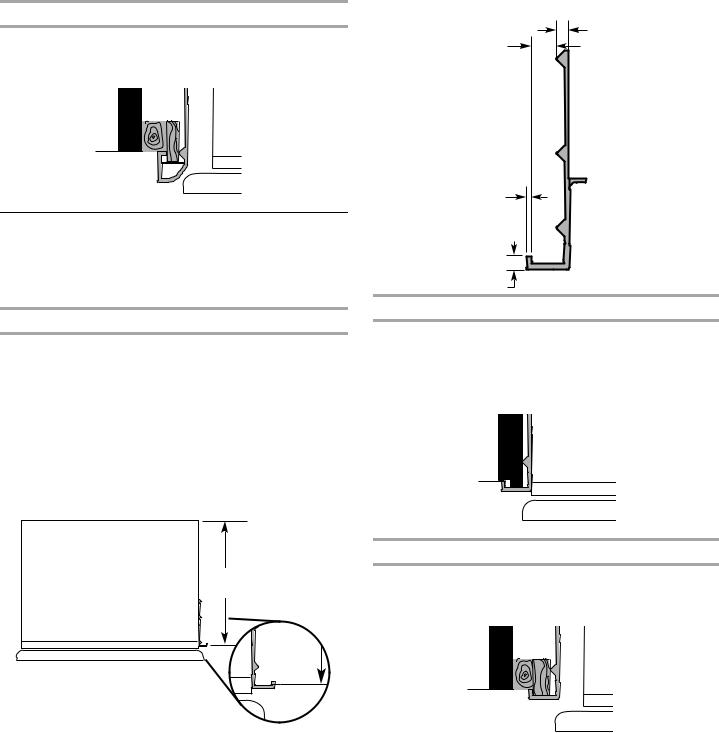
Recessed Inset Installation Dimensions
1.Measure the distance from point A (as shown) to back wall.
2.Rout the front edge of the support board or attach a ¹⁄ " (6.35 mm) board to hold the panel in the cabinet side trim.
A
ClassicandOverlaySeriesCustom Side Panels
Custom side panels may be needed when not enough space is available to have cabinets on both sides of the refrigerator or when the refrigerator is placed and the end of a cabinet run. You may choose an Inset or Recessed Inset panel installation.
Refrigerator and Side Trim Dimensions
The width and height of a side panel are determined by the type of installation you are planning.
NOTES:
■The dimensions shown are actual product dimensions and may not reflect the needed installation dimensions.
■The side panel should be a minimum of ¹⁄ " (1.27 cm) thick to prevent warping.
■If the opening depth is 25" (63.5 cm) or more, you may want to install a support board on the rear wall.
Refrigerator
Overlay
23³⁄ "
(59.40 cm)
Side Trim
³⁄ "
(4.5 mm)
³⁄ " (9.7 mm)
¹⁄ " (1.5 mm)
¹⁄ " (3.2 mm)
Inset Installation Dimensions
1.Measure the distance from point A (as shown) to the back wall. Add ¹⁄ " (0.8 mm) to this measurement to allow the side panel to fit into the trim.
2.If the panel is more than ³⁄ " (9.5 mm) thick, rout the front edge to allow the side panel to fit into the trim.
A
Recessed Inset Installation Dimensions
1.Measure the distance from point A (as shown) to back wall.
2.Rout the front edge of the support board or attach a ³⁄ " (9.5 mm) board to hold the panel in the cabinet side trim.
A
13
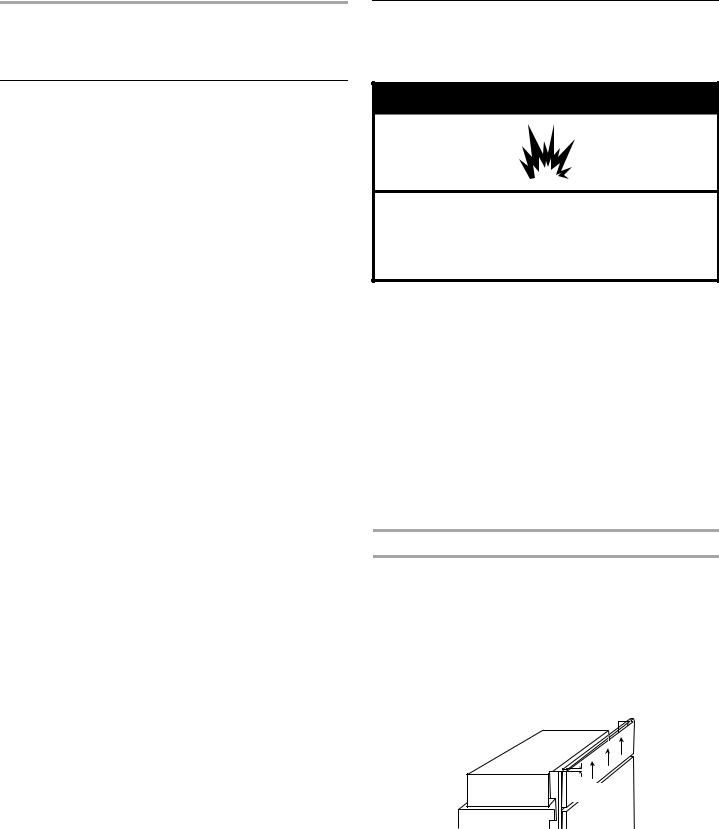
INSTALLATION
REQUIREMENTS
ToolsandParts
IMPORTANT:
■Installer: Leave Installation Instructions with the homeowner.
■Homeowner: Keep Installation Instructions for future reference. Save these Installation Instructions for the local electrical inspector’s use.
TOOLS NEEDED:
Gather the required tools and parts before starting installation. Read and follow the instructions provided with any tools listed here.
■ Hand drill or electric drill |
■ |
Torx®† T27 screwdriver |
|
|
(properly grounded) |
|
|
■ |
Drill bits |
■ |
¹¹⁄" nut driver |
■ |
Two adjustable wrenches |
■ |
³⁄" and ¹⁄" open-end |
|
|
|
wrenches |
■ |
Phillips screwdriver |
■ |
⁄" Allen wrench |
■ |
Small level |
■ |
⁄" socket wrench |
■ |
Appliance dolly |
■ |
Tape measure |
PARTS NEEDED:
■Six #8 x 3" (7.6 cm) wood screws (longer screws may be needed)
■One or two 2" x 4" x 32" (5 cm x 10 cm x 81 cm) wood board(s)
■Order factory panels, make custom panels or consult a qualified cabinetmaker or carpenter to make the panels.
Classic Series: Order factory panels, make custom panels, or consult a qualified cabinetmaker or carpenter to make the panels. See “Design Specifications” for more information.
Overlay Series: Make custom panels, or consult a qualified cabinetmaker or carpenter to make the panels. See “Design Specifications” for more information.
Complete, Architect® and Pro Line® Series are shipped complete.
■If you are connecting the water line directly to copper tubing and not to a shutoff valve, you need a ferrule, a union, and a ¹⁄" (6.35 mm) compression fitting.
LocationRequirements
The refrigerator can be recessed in an opening between cabinets or installed at the end of a cabinet run using a side panel to enclose the refrigerator.
 WARNING
WARNING
Explosion Hazard
Keep flammable materials and vapors, such as gasoline, away from refrigerator.
Failure to do so can result in death, explosion, or fire.
IMPORTANT:
■Observe all governing codes and ordinances.
■It is recommended that you do not install the refrigerator near an oven, radiator, or other heat source.
■Do not install in a location where the temperature will fall below 55°F (13°C).
■Floor must support the refrigerator weight, more than 600 lbs (272 kg), door panels and contents of the refrigerator.
■Ceiling height must allow for side tipping radius. See “Tipping Radius.”
■Location should permit door to open fully. See “Door Swing Dimensions.”
■Location must permit top grille removal. See “Opening Dimensions.”
Opening Dimensions
■The solid soffit must be within 1" (2.5 cm) maximum above the refrigerator. If the solid soffit is higher than 1" (2.5 cm) or one is not available, then the refrigerator must be braced to prevent tipping during use.
If the anti-tip boards are needed, they must be attached to the rear wall studs 80" to 90" (203 - 229 cm) above the floor. See “Install Anti-Tip Boards” for more information.
NOTE: A clearance of ¹⁄" (1.3 cm) must be maintained in front of the refrigerator’s side trim in order for the top grille to be removed.
¹⁄"
(1.3 cm)
■ A grounded 3 prong electrical outlet should be placed within 4" (10.2 cm) of the right side cabinets or end panel. See “Electrical Requirements” for additional information.
■ The water shutoff should be located in the base cabinet on either side of the refrigerator or some other easily accessible area. If the water shutoff valve is not in the cabinets, the plumbing for the water line can come through the floor or the
†®TORX is a registered trademark of Textron Innovations Inc.
14
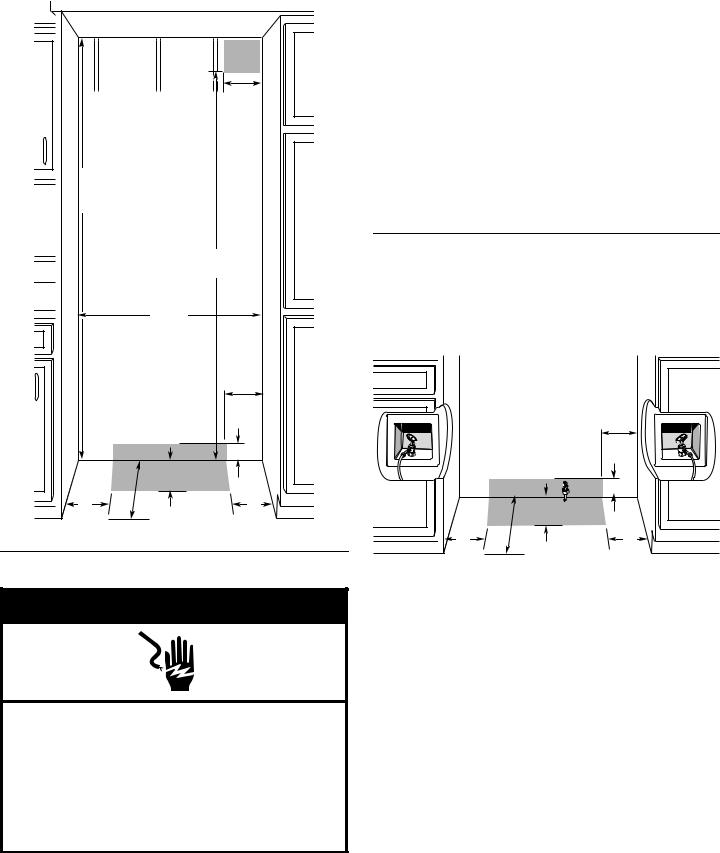
back wall. See “Water Supply Requirements” for more specific information.
80" - 90" |
|
(203-229 cm) |
4" |
|
|
|
(10.2 cm) |
83¹⁄ " (211.5 cm) min. |
|
84³⁄ " (215 cm) max. |
|
to bottom of solid soffit |
|
|
77" |
|
(196 cm) |
35¹⁄ " |
|
(90.2 cm) |
|
|
6" |
|
(15.2 cm) |
|
3" |
|
(7.6 cm) |
11" |
|
(28 cm) |
|
6" |
6" |
(15.2 cm) |
(15.2 cm) |
23¹⁄ " |
|
(60 cm) min. |
|
ElectricalRequirements
 WARNING
WARNING
Electrical Shock Hazard
Plug into a grounded 3 prong outlet.
Do not remove ground prong.
Do not use an adapter.
Do not use an extension cord.
Failure to follow these instructions can result in death, fire, or electrical shock.
Before you move your refrigerator into its final location, it is important to make sure you have the proper electrical connection.
Recommended Grounding Method
A 115 Volt, 60 Hz., AC only 15or 20-amp fused, grounded electrical supply is required. It is recommended that a separate circuit serving only your refrigerator be provided. Use an outlet that cannot be turned off by a switch. Do not use an extension cord.
IMPORTANT: If this product is connected to a GFCI (Ground Fault Circuit Interrupter) protected outlet, nuisance tripping of the power supply may occur, resulting in loss of cooling. Food quality and flavor may be affected. If nuisance tripping has occurred, and if the condition of the food appears poor, dispose of it.
NOTE: Before performing any type of installation, cleaning, or removing a light bulb, remove the top grille and turn the master power switch to OFF or disconnect power at the circuit breaker box.
When you are finished, turn ON the master power switch or reconnect power at the circuit breaker box. Then reset the control to the desired setting.
WaterSupplyRequirements
■All installations must meet local plumbing code requirements.
■The water shutoff should be located in the base cabinet on either side of the refrigerator or some other easily accessible area. The right-hand side is recommended. The access hole through the right-hand side cabinet must be within ¹⁄ "
(12.7 mm) of the rear wall.
|
6" |
|
(15.2 cm) |
|
3" |
|
(7.6 cm) |
|
11" |
|
(28 cm) |
6" |
6" |
2 cm) |
(15.2 cm) |
|
23¹⁄ " |
(60 cm) min.
■If the water shutoff valve is not in the cabinets, the plumbing for the water line can come through the floor or the back wall. A ¹⁄ " (12.7 mm) hole for plumbing should be drilled 6"
(15.2 cm) to 12" (30.4 cm) from the right-hand side cabinet or panel. On the floor, the hole should be no more than 11"
(28 cm) away from the back wall. On the wall, the hole should be no more than 3" (7.6 cm) up from the floor. See “Connect the Water Supply.”
If this recommended water line location is used, no additional plumbing must be purchased.
■If additional tubing is needed, use copper tubing and check for leaks. Install the copper tubing only in areas where the household temperatures will remain above freezing.
■Do not use a piercing-type or ³⁄ " (4.76 mm) saddle valve which reduces water flow and clogs more easily.
NOTE: Your refrigerator dealer has a kit available with a ¹⁄ " (6.35 mm) saddle-type shutoff valve, a union, and copper tubing. Before purchasing, make sure a saddle-type valve complies with your local plumbing codes.
15
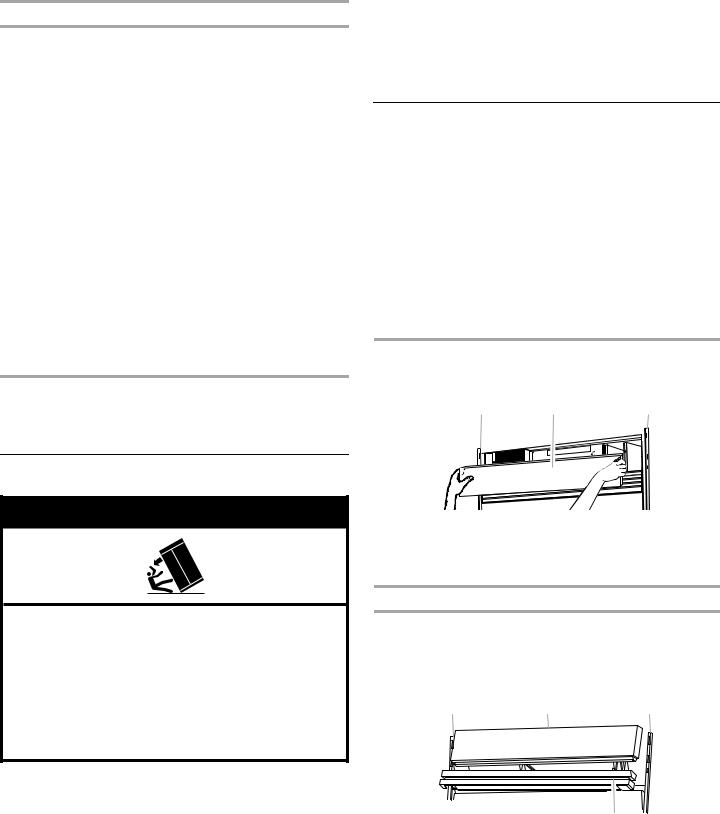
Water Pressure
A cold water supply with water pressure between 30 and 120 psi (207 - 827 kPa) is required to operate the water dispenser and ice maker. If you have questions about your water pressure, call a licensed, qualified plumber.
Reverse Osmosis Water Supply
IMPORTANT: The pressure of the water supply coming out of a reverse osmosis system going to the water inlet valve of the refrigerator needs to be between 30 and 120 psi (207 - 827 kPa).
If a reverse osmosis water filtration system is connected to your cold water supply, the water pressure to the reverse osmosis system needs to be a minimum of 40 to 60 psi (276 - 414 kPa).
If the water pressure to the reverse osmosis system is less than 40 to 60 psi (276 - 414 kPa):
■Check to see whether the sediment filter in the reverse osmosis system is blocked. Replace the filter if necessary.
■Allow the storage tank on the reverse osmosis system to refill after heavy usage.
■If your refrigerator has a water filter cartridge, it may further reduce the water pressure when used in conjunction with a reverse osmosis system. Remove the water filter cartridge.
If you have questions about your water pressure, call a licensed, qualified plumber.
INSTALLATION
INSTRUCTIONS
UnpacktheRefrigerator
 WARNING
WARNING
Tip Over Hazard
Refrigerator is top heavy and tips easily when not completely installed.
Keep doors taped closed until refrigerator is completely installed.
Use two or more people to move and install refrigerator.
Failure do so can result in death or serious injury.
IMPORTANT:
■Do not remove the protective film until the refrigerator is in its operating position.
■All four leveling legs must contact the floor to support and stabilize the full weight of the refrigerator.
■Keep the cardboard shipping piece or plywood under the refrigerator until it is installed in the operating position.
1.Remove and save the literature package and parts bag taped to the refrigerator door. Remove the four brackets (two on each side) that attach the shipping base to the refrigerator bottom.
NOTE: Do not remove tape and door bracing until the refrigerator is in its final position.
2.If necessary, reduce the tipping radius. See “Tipping Radius” for ceiling height requirements or “Reduce Tipping Radius” for step-by-step instructions. If you do not need to reduce the tipping radius, proceed to “Move the Refrigerator into House.”
ReduceTippingRadius
(ifrequired)
Before bringing the refrigerator into the home, be sure there is adequate ceiling height to stand the refrigerator upright. See “Tipping Radius” in the “Design Specifications” section for more information.
If you do not have adequate ceiling height to stand the refrigerator upright, the tipping radius can be reduced by removing the top grille and side trims (see the following chart).
|
Model |
Reduced Tipping Radius |
|
|
|
|
|
|
36 |
88" (223.5 cm) |
|
|
|
|
|
|
|
|
|
Classic and Overlay Series
1.Grasp both ends of the top grille.
2.Push the top grille straight up; then pull straight out. Lay the grille on a soft surface.
B A B
A.Top grille
B.Cabinet side trim
3.Remove the six screws attaching each cabinet side trim to the refrigerator and remove the side trims.
Architect® Series
1.Grasp both ends of the louver panel. Push the louver panel straight up; then pull straight out. Lay the panel on a soft surface.
2.Grasp both ends of the top grille. Push the top grille straight up; then pull straight out. Lay the top grille on a soft surface.
B A B
C
A.Top grille
B.Cabinet side trim
C.Louver panel
3.Remove the six screws attaching each cabinet side trim to the refrigerator and remove the side trims.
16
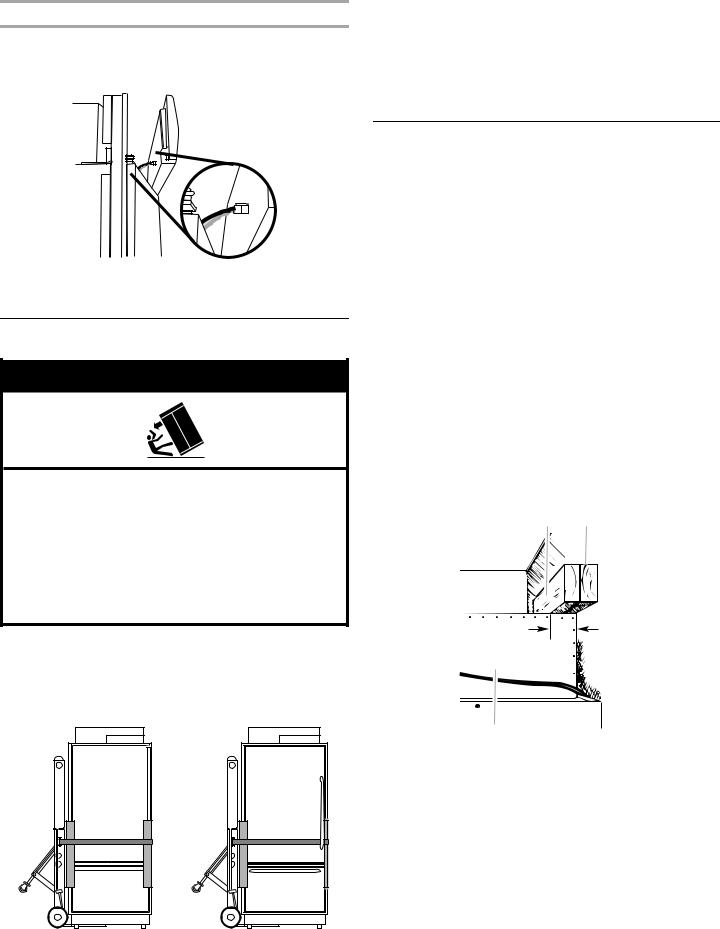
Pro Line™ Series
1.Grasp both ends of the top grille.
2.Push the top grille straight up, and then pull straight out.
3.Disconnect the wiring harness from the back of the top grille.
4.Lay the top grille on a soft surface.
5.Remove the six screws that attach each cabinet side trim to the refrigerator, and remove the side trims.
MovetheRefrigeratorintoHouse
 WARNING
WARNING
Tip Over Hazard
Refrigerator is top heavy and tips easily when not completely installed.
Keep doors taped closed until refrigerator is completely installed.
Use two or more people to move and install refrigerator.
Failure do so can result in death or serious injury.
1.Place an appliance dolly under the left side of the refrigerator as shown. Be sure to protect the side trims and handles. Place the corner posts from the packing materials over the trims and handles as appropriate. Slowly tighten the strap.
NOTE: Pass the dolly strap under the handles for the Architect® Series.
2.Place pieces of the shipping carton on the floor when rolling the dolly and refrigerator into the house. Move the refrigerator close to the built-in opening.
3.Place top of cardboard carton or plywood under refrigerator. Remove dolly.
4.Do not remove protective film or cover.
5.If necessary, reassemble the trim and top grille after the dolly has been removed from the refrigerator.
InstallAnti-TipBoards
IMPORTANT:
■The solid soffit must be within 1" (2.5 cm) maximum above the refrigerator. If the solid soffit is higher than 1" (2.5 cm) or one is not available, prevent the refrigerator from tipping during use as shown.
■It is recommended that board(s) be installed before the refrigerator is installed.
■Board(s) must be long enough to fully cover the width of the compressor cover.
■Locate the board(s) so the bottom surface(s) of the board(s) is(are) 84" (213 cm) from the floor.
■During installation, raise the refrigerator up so there is ¹⁄" (6.35 mm) maximum between the top of the refrigerator and the bottom of the anti-tip board(s). Do not crush the condenser cover when raising the rear leveling legs.
To Install Anti-tip Boards
1.Mark the stud locations on rear wall 80" to 90" (203 cm to 229 cm) above floor.
2.Securely attach one or two 2" x 4" x 32" (5 cm x 10 cm x
81 cm) wood boards to wall studs behind refrigerator. Use six #8 x 3" (7.6 mm) (or longer) wood screws. The wood screws must be screwed into the studs at least 1½" (3.8 cm). The board(s) must overlap the compressor cover.
A B





 C
C
2" (5 cm)
D
A.Center board ¹⁄" (6.35 mm) max. above refrigerator
B.Two 2" x 4" x 32" (5 cm x 10 cm x 81 cm) boards
C.Attach to studs with six #8 x 3" (7.6 cm) screws
D.Compressor cover
17
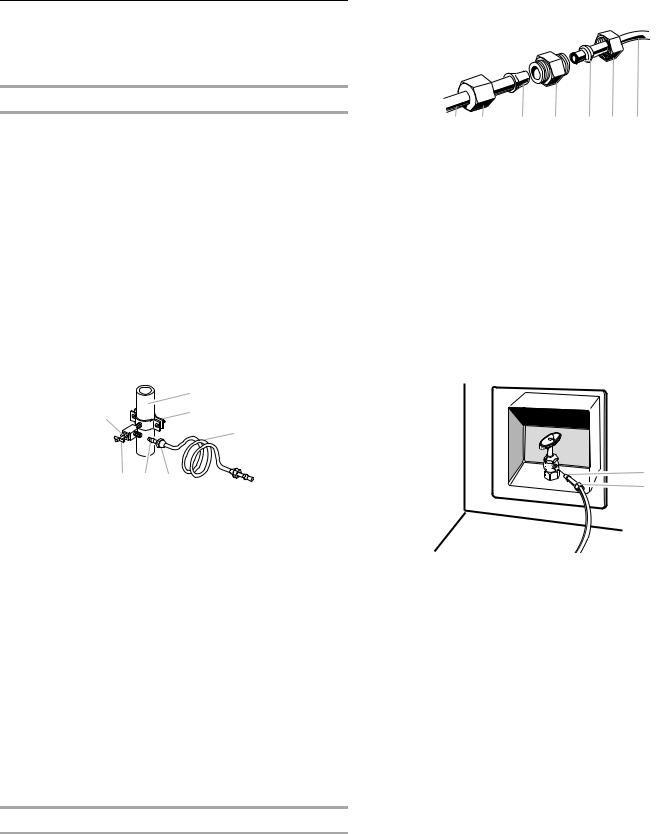
ConnecttheWater Supply
Read all directions before you begin.
IMPORTANT: If you turn the refrigerator on before the water line is connected, turn the ice maker OFF.
Connect to Water Line
1.Unplug refrigerator or disconnect power.
2.Turn OFF main water supply. Turn ON nearest faucet long enough to clear line of water.
3.Locate a ½" to 1¹⁄ " (1.25 cm to 3.18 cm) vertical cold water pipe near the refrigerator.
IMPORTANT:
■Make sure it is a cold water pipe.
■Horizontal pipe will work, but drill on the top side of the pipe, not the bottom. This will help keep water away from the drill and normal sediment from collecting in the valve.
4.Determine the length of copper tubing you need. Measure from the connection on the lower left rear of refrigerator to the water pipe. Add 7 ft (2.1 m) to allow for cleaning. Use ¹⁄ " (6.35 mm) O.D. (outside diameter) copper tubing. Be sure both ends of copper tubing are cut square.
5.Using a grounded drill, drill a ¹⁄ " hole in the cold water pipe you have selected.
|
A |
G |
B |
|
|
|
C |
F E |
D |
A. Cold water pipe |
E. Compression sleeve |
B. Pipe clamp |
F. Shutoff valve |
C. Copper tubing |
G. Packing nut |
D.Compression nut
6.Fasten the shutoff valve to the cold water pipe with the pipe clamp. Be sure the outlet end is solidly in the ¹⁄ " drilled hole in the water pipe and that the washer is under the pipe clamp. Tighten the packing nut. Tighten the pipe clamp screws slowly and evenly so washer makes a watertight seal. Do not overtighten, or you may crush the copper tubing.
7.Slip the compression sleeve and compression nut on the copper tubing as shown. Insert the end of the tubing into the outlet end squarely as far as it will go. Screw compression nut onto outlet end with adjustable wrench. Do not overtighten the clamp or the sleeve. This will crush the copper tubing.
8.Before attaching copper tubing to the refrigerator place the free end of the tubing in a container or sink and turn on the main water supply. Flush at least 2 qt (1.9 L) of water through the copper tubing until water is clear to get rid of any particles in the water line. Turn off the shutoff valve on the water pipe. Coil the copper tubing.
9.Check for leaks around the saddle valve.
Connecting to Refrigerator
Style 1 - Copper Line Connection
1.Remove the shipping tape from the gray, coiled water tubing on the rear of the refrigerator.
2.A ¹⁄ " x ¹⁄ " coupling is needed in order to connect the water tubing to an existing household water line. Thread the provided nut onto the coupling on the end of the copper tubing.
NOTE: Tighten the nut by hand. Then tighten it with a wrench two more turns. Do not overtighten.
A |
B |
C |
D |
E F G |
A. Refrigerator water tubing |
|
E. Ferrule (purchased) |
||
B. Nut (provided) |
|
|
F. Nut (purchased) |
|
C. Bulb |
|
|
|
G. Household water |
D. Coupling (provided) |
|
line |
||
3.Turn shutoff valve ON.
4.Check for leaks. Tighten any nuts or connections (including connections at the valve) that leak.
NOTE: Allow 24 hours to produce the first batch of ice. Discard the first three batches of ice produced. Allow 3 days to completely fill ice container.
Style 2 - Shutoff Valve Connection
1.Remove the shipping tape from the gray, coiled water tubing on the rear of the refrigerator.
2.Thread the provided nut onto the water valve as shown.
NOTE: Tighten the nut by hand. Then tighten it with a wrench two more turns. Do not overtighten.
A |
B |
A.Bulb
B.Nut (provided)
3.Turn shutoff valve ON.
4.Check for leaks. Tighten any nuts or connections (including connections at the valve) that leak.
NOTE: Allow 24 hours to produce the first batch of ice. Discard the first three batches of ice produced. Allow 3 days to completely fill ice container.
18
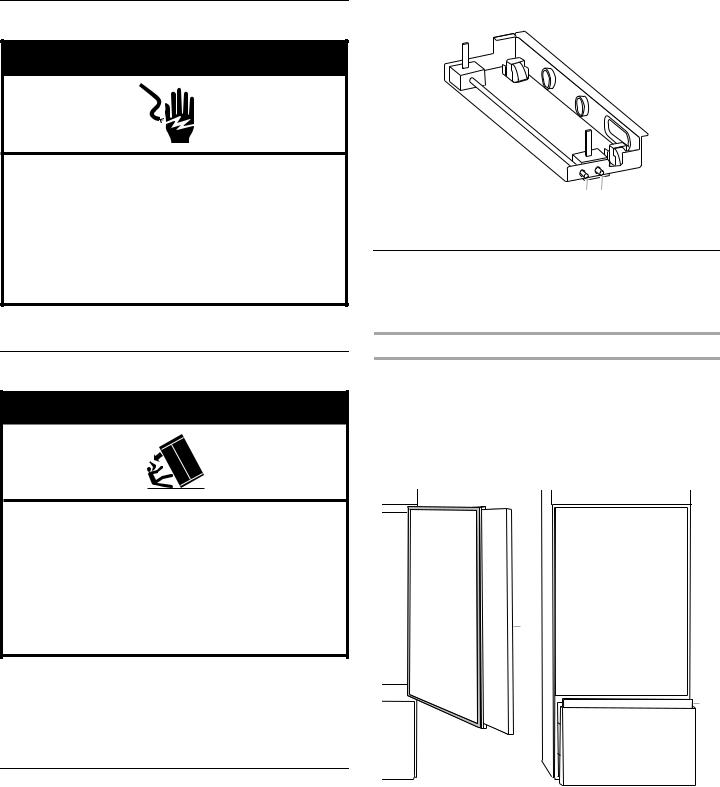
PluginRefrigerator
To avoid cabinet damage, do not apply more than 50 inchpounds (58 cm - kg) of torque to the leveling legs.
 WARNING
WARNING
Electrical Shock Hazard
Plug into a grounded 3 prong outlet.
Do not remove ground prong.
Do not use an adapter.
Do not use an extension cord.
Failure to follow these instructions can result in death, fire, or electrical shock.
1.Set control switch at top of cabinet to the OFF position.
2.Plug into a grounded 3 prong outlet.
MoveRefrigeratortoFinalLocation
 WARNING
WARNING
Tip Over Hazard
Refrigerator is top heavy and tips easily when not completely installed.
Keep doors taped closed until refrigerator is completely installed.
Use two or more people to move and install refrigerator.
Failure do so can result in death or serious injury.
IMPORTANT: To prevent floor damage, make sure levelers are raised (not touching floor) and refrigerator is on rollers before moving.
1.Move the refrigerator straight back and evenly into the opening. Be sure that water tubing is not kinked and the power supply cord is on top of the refrigerator next to the cover.
LowerLevelingLegs
NOTE: All four leveling legs must contact the floor to support and stabilize the full weight of refrigerator. Rollers are for moving refrigerator and not for permanent support.
Use socket wrench to turn leg levelers on both sides of refrigerator to the right (clockwise) until refrigerator weight is supported by leveling legs. The rollers should be off the floor.
A B
A.Rear leveling legs
B.Front leveling legs
InstallClassicSeriesCustomPanels
IMPORTANT: KitchenAid is not responsible for the removal or addition of molding or decorative panels that would prevent the refrigerator from being serviced.
Door and Drawer Panels
1.Remove all tape and door bracing from the refrigerator door and freezer drawer.
2.Remove the screws that attach the handle to the frame.
3.Slide the decorative door panel into the frame.
4.If needed, rout the door and drawer panels or install a filler panel between the door and drawer and the decorative panels. See the “Classic Series Custom Panels” section in “Design Specifications.”
A
B
A.Door panel
B.Drawer panel
5.Replace the door and drawer handles. Be sure that the door and drawer are aligned.
19
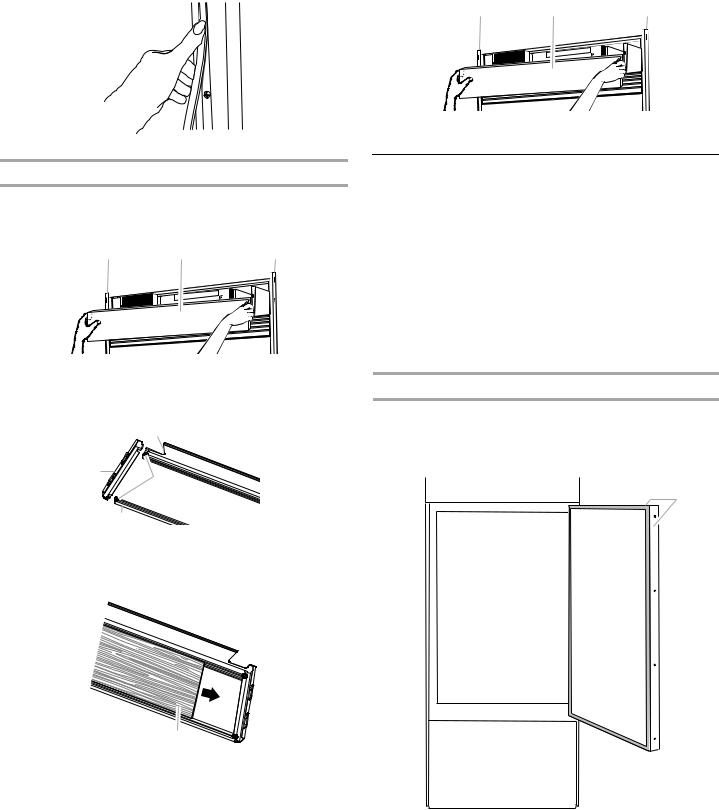
6.Remove the protective skin from the screw covers. Snap the screw covers into the handle trim section.
7. If the door gap is uneven, see “Adjust and Remove Door.”
Top Grille Panel
1.Grasp both ends of the top grille.
2.Push straight up; then pull straight out. Place the top grille panel-side down on a soft working surface.
B A B
A.Top grille
B.Cabinet side trim
3.Remove one end cap by loosening the nuts and sliding the end cap off.
A |
|
C |
|
B |
|
D |
|
A. Bottom rail |
C. End cap |
B. Nuts |
D. Top rail |
4.Slide the panel into the top grille channel and reattach the end cap.
A
A. Panel
5.Replace the top grille in the cabinet side trims and pull the panel down slightly to lock it into place.
B A B
A.Top grille
B.Cabinet side trim
InstallOverlaySeriesCustomPanels
IMPORTANT:
■Install the custom handles prior to installing the panels on the refrigerator. For more information on KitchenAid custom handle selection, refer to the KitchenAid Catalog, visit www.kitchenaid.com, or call 1-800-422-1230.
In Canada, visit www.KitchenAid.ca, or call
1-800-461-5681.
■Create custom door overlay panels according to the specifications in the “Overlay Series Custom Panels” section.
■KitchenAid is not responsible for the removal or addition of molding or decorative panels that would prevent the refrigerator from being serviced.
Door Panel Installation
1.Remove all tape and door bracing from the refrigerator door and freezer drawer.
2.Open the refrigerator door and freezer drawer and remove the trims.
A
B
A.Refrigerator door trims
B.Freezer drawer trim
20
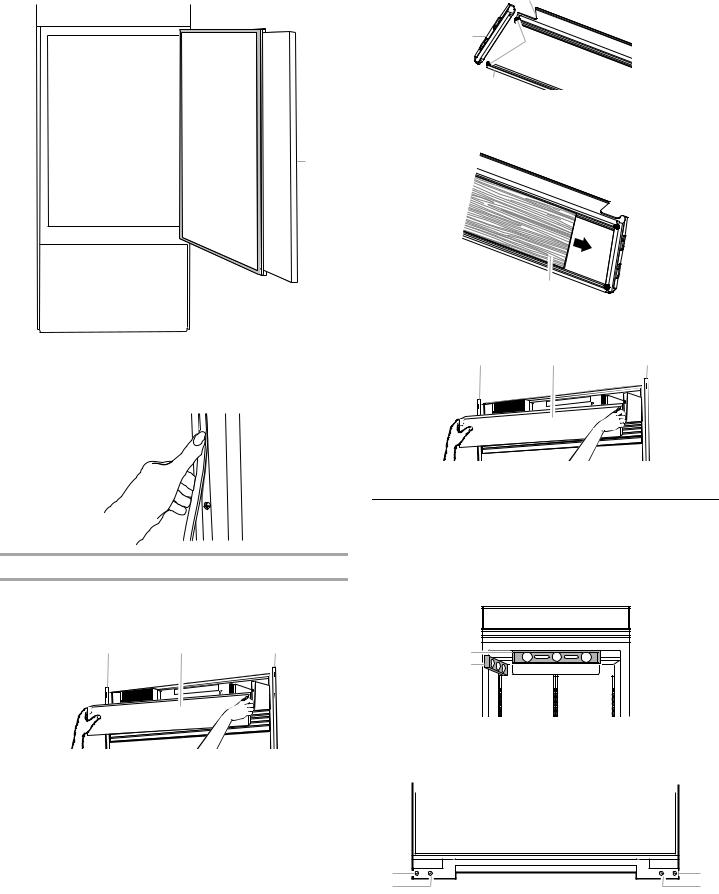
3.Slide the custom panels into the trims on the refrigerator door and freezer drawer, making sure that the backer panel fits into the hinge side trims.
A
A.Panels
4.Reinstall the handle-side and top trims.
5.Remove the protective skin from the screw covers. Snap the screw covers into the handle trim section.
Top Grille Panel
1.Grasp both ends of the top grille.
2.Push straight up; then pull straight out. Place the top grille panel-side down on a soft working surface.
B A B
A.Top grille
B.Cabinet side trim
3.Remove one end cap by loosening the nuts and sliding the end cap off.
A |
|
C |
|
B |
|
D |
|
A. Bottom rail |
C. End cap |
B. Nuts |
D. Top rail |
4.Slide the panel into the top grille channel and reattach the end cap.
A
A.Panel
5.Replace the top grille in the cabinet side trims and pull the panel down slightly to lock it into place.
B A B
A.Top grille
B.Cabinet side trim
LevelRefrigerator
NOTE: Custom or full-overlay door panels must be installed before leveling.
1.Open the door and place the level on top of the refrigerator frame as shown. Check to see whether the refrigerator is level from left to right.
A |
B |
A.Level to check left to right leveling
B.Level to check front to back leveling
2.Use the leveling bolts to adjust the leveling legs until the refrigerator is level from left to right.
A |
A |
B |
B |
A. Rear leveling bolt
B. Front leveling bolt
21
